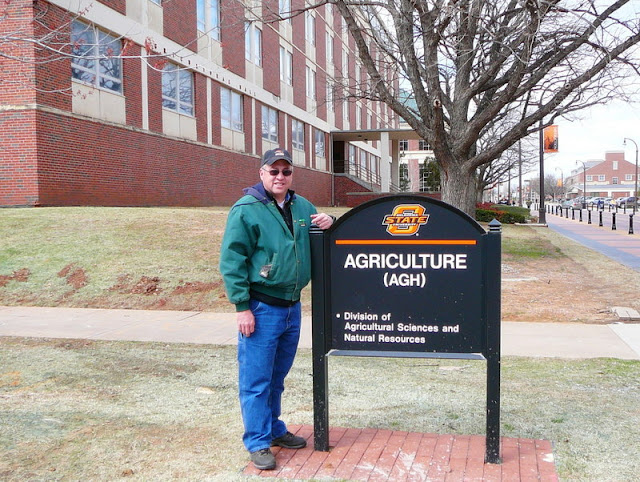So to refresh, I was in Oklahoma last week on a fertilizer mission. Part of that was to visit some plots we have with a contract researcher West Central OK. Below are some of the topdress plots there. This was late-planted wheat, on Novemeber 8. The plot in the middle was topdressed 5 weeks ago with 20 gal/A of 28-0-0-5/eNhance. This is a common topdress in this area. To the right is 20 gal/A of straight 28%. There are a number of treatments that we will follow through harvest.
I wouldn't dare go by myself to see all this. So I was happy to have Area Manager Parker Christian and Sales Account Manager Jacob with me on this mission. We had alot to see in this area.
I noticed a lot of canola fields this year. Canola has come and gone many times in Oklahoma. I guess this is a come year. The field below had Liquid: Pro-Germinator + Micro 500 + some 28-0-0-5/eNhance in a surface band at planting last fall and topdress streaming of 28-0-0-5/eNhance in February. It is in 30 inch rows as it is easier to plant in no-till wheat stubble and also due to moisture management. That is, there isn't much moisture, so plant in wide rows.
Like much of the plains, drought was a big issue last year. Here is a field that was planted to cotton last year, but was not harvested due to drought. So wheat was planted last fall. It has been topdressed and is looking good now. But some rain would help.
Here on the headlands, we were curious if there would be any effect of last year's surface band of Pro-Germinator. If you look hard you may see that the wheat is bigger around the stalks where the fertilizer was banded last year. There was no fertilizer applied with the wheat. So hopefully it will still be usable to this crop of wheat. We visited several fields that had the same situation.
And there were plenty of fields of good looking wheat that had Pro-Germinator + Micro 500 through the drill and topdressed with the previously mentioned mix. It was interesting to see that all of the AgroLiquid treated fields had good uniformity, color and size. They stood out compared to the conventional fields.
Back at Jacob's home, brother Ben called and asked if he would bring down a nurse tank to where he was planting corn. So he brought the trailer of Pro-Germinator + Micro 500 down to where he was. They have a new 16 row planter that even has the row shut offs for feritlizer and seed on point rows and headlands so that you don't overlap. This has already saved seed and fertilizer. But they said all of the equipment is so complicated that they pray every day that it doesn't break down.
As I showed in the previous post, it was exceptionally cold this week. In fact, it got down to 20 degrees a couple nights prior to this picture. You can see some frosted wheat tips, but I don't think it got down into the stalk where the head is developing. It had warmed up by the end of the week.
Here is a field from the Nowakowski Farm near McLoud. It looks good. But like all fields, it could use a drink. Well on Friday night there were scattered thunderstorms. Up by Todd, he got from a quarter inch to over an inch. Jacob didn't get any rain, and it was light in Parker's area and at the plots. Such are thunderstorms.
So I made the long drive back to Michigan. I do hope everyone had a nice and meaningful Easter. Can't believe tomorrow is April. Field work is close here in the land of NCRS.




























